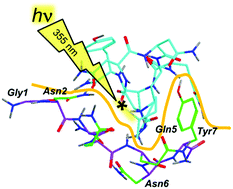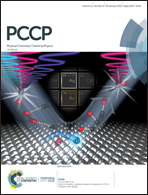Non-covalent complexes of the peptide fragment Gly-Asn-Asn-Gln-Gln-Asn-Tyr in the gas-phase. Photodissociative cross-linking, Born–Oppenheimer molecular dynamics, and ab initio computational binding study†
Abstract
Non-covalent complexes of the short amyloid peptide motif Gly-Asn-Asn-Gln-Gln-Asn-Tyr (GNNQQNY) with peptide counterparts that were tagged with a diazirine ring at the N-termini (*GNNQQNY) were generated as singly charged ions in the gas phase. Specific laser photodissociation (UVPD) of the diazirine tag in the gas-phase complexes at 355 nm generated transient carbene intermediates that underwent covalent cross-linking with the target GNNQQNY peptide. The crosslinking yields ranged between 0.8 and 4.5%, depending on the combinations of peptide C-terminal amides and carboxylates. The covalent complexes were analyzed by collision-induced dissociation tandem mass spectrometry (CID-MS3), providing distributions of cross-links at the target peptide amino acid residues. A general preference for cross-linking at the target peptide Gln-4-Gln-5-Asn-6-Tyr-7 segment was observed. Born–Oppenheimer molecular dynamics calculations were used to obtain 100 ps trajectories for nine lowest free-energy conformers identified by ωB97X-D/6-31+G(d,p) gradient geometry optimizations. The trajectories were analyzed for close contacts between the incipient carbene atom and the X–H bonds in the target peptide. The close-contact analysis pointed to the Gln-5 and Tyr-7 residues as the most likely sites of cross-linking, consistent with the experimental CID-MS3 results. Non-covalent binding in the amide complexes was evaluated by DFT calculations of structures and energies. Although antiparallel arrangements of the GNNQQNY and *GNNQQNY peptides were favored in low-energy gas-phase and solvated complexes, the conformations and peptide–peptide interface surfaces were found to differ from the secondary structure of the dry interface in GNNQQNY motifs of amyloid aggregates.

- This article is part of the themed collection: 1st International Conference on Noncovalent Interactions


 Please wait while we load your content...
Please wait while we load your content...